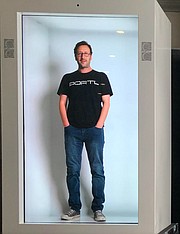INDUSTRY FOCUS: SUSTAINABILITY
Industry Focus: Sustainability—What is the biggest accomplishment in fashion sustainability that has been achieved over the last five years and what are the next steps to expand upon it?
Despite its once fringe status, sustainable living has reached closer into the mainstream fashion market, and what was, in the past, a lifestyle choice has now become a necessity. On Feb. 27, the United Nations Intergovernmental Panel on Climate Change released its report, “Climate Change 2022: Impacts, Adaptation and Vulnerability,” which identifies how the climate crisis is headed toward an irreversible state that will change life for all beings on the planet.
Many brands, manufacturers, designers and supply-chain resources within the fashion industry are cleaning up their practices, step by step. Some have been proponents of sustainable practices since they founded their companies while others have been focusing on an approach that values progress over perfection as they avoid greenwashing through genuine efforts to adopt true green practices.
There has also been a realization that sustainable practices reach beyond environmental concerns to include issues surrounding gender equity and workplace standards that promote a safe environment. As fashion focuses on progress within the sustainable-apparel-making segment, California Apparel News asked sustainability experts and those who are gaining ground in this space: What is the biggest accomplishment in fashion sustainability that has been achieved over the last five years and what are the next steps to expand upon it?
Mukul Agrawal
Chief Sustainability Officer
Birla Cellulose
It is now more urgent than ever for the fashion industry to shift from a linear—take, make, use, dispose—model to a circular model. The man-made cellulosic-fibers process has a unique capability to recycle pre- and post-consumer cotton waste into fresh fibers.
Birla Cellulose developed innovative in-house proprietary technology for recycling pre-consumer cotton waste into fresh viscose fibers akin to regular fibers and launched Liva Reviva with 20 percent feedstock as pre-consumer waste.
Circularity is one of the key focus areas for us. We are part of several consortium projects working toward next gen solutions such as Liva Reviva. Birla Cellulose is aggressively working on scaling the next-generation fibers up to 100,000 tons by 2024 and increasing the recycled content of both pre- and post-consumer waste.
We have emerged as a winner in the first edition of the National Innovative and Sustainable Supply Chain Awards by UN Global Compact Network India for its case study on “Liva Reviva & Fully Traceable Circular Global Fashion Supply Chains.”
Birla Cellulose was also ranked No. 1 among global MMCF producers in Canopy’s Hot Button Report 2021 for the third consecutive year. The top ranking in the environmental report reflects our relentless attempt to improve sustainable wood-sourcing practices, conservation of forests and development of next-generation fiber solutions.
Michal Arbel
Sustainability Communication Lead
Kornit Digital
There has been essential focus and effort placed on the fight against overproduction in the fashion industry in recent years. The main purpose of this has been to prevent unsold items from being incinerated or going to landfills. By changing the way fashion is manufactured and producing only what is genuinely needed and will be sold, producers can make a large and impactful contribution to resource conservation. This impact prevents the major problem of unsold items without demand. Kornit Digital technology disrupts the traditional fashion-manufacturing industry and enables on-demand fashion production.
Enrica Arena
Co-founder and Chief Executive Officer
Orange Fiber
We believe that the biggest goal that has been achieved in fashion over the last five years is that sustainability has become a crucial theme for brands and retailers.
Sustainability has established itself as a market trend associated with positive and measurable economic results for the companies that adopt it, validating the business models that are based on it and accelerating the conversion of supply chains.
From circular design to certifications that measure claims and impact; innovative technological systems to make the supply chain fully transparent, traceable and accessible to customers; passing through the choice of sustainable materials such as our fabrics from citrus-juice by-products; and regenerative production and end-of-life management systems, the fashion industry is increasingly committed to making good intentions on environmental protection a reality.
However, the global fashion industry remains complex, fragmented and still partly opaque, with unsafe working conditions in some production sites around the world and causing environmental pollution and social exploitation.
We believe that through the adoption of common rules and thanks to the joint action and commitment of brands and clients, sound sustainable fashion for people and planet will be the standard in the future.
Kerry Bannigan
Executive Director
Fashion Impact Fund
Over the last five years the fashion industry has faced—whether through industry advocacy or consumer demand—that not only is it possible to create an ecosystem that values people and planet but that the systems and solutions exist to achieve transformational sector change. While progress is being made on these fronts by some stakeholders, the industry still lacks the education, legislation and finances necessary for immediate substantial change.
It is no understatement that for progress to be achieved it is critical that the fashion industry prioritize gender equality with women being fairly represented throughout the value chain. Myself, I want to see more support for women entrepreneurs who are accelerating the fashion industry’s transition to an equitable, inclusive and regenerative sector. Global media should be amplifying their visibility, and financing should be more accessible to women and their communities, who are driving forces for sustainable development in the fashion ecosystem. It is imperative to support their leadership as they are addressing the critical issues of our time.
Ayesha Barenblat
Founder and Chief Executive Officer
Remake
The biggest accomplishment to creating a more just and accountable fashion system was the passage of California’s Senate Bill 62, the Garment Worker Protection Act. This bill addresses the root causes of wage theft, which is so endemic in the fashion system, by eliminating the piece-rate system of pay and holding brands jointly liable for the wages stolen from garment workers.
The bill is an example of extraordinary worker-led organizing, broad and deep coalition building, and remarkable solidarity from businesses and citizens that succeeded in closing a major regulatory gap in the United States’ largest apparel-producing hub. As of Jan. 1, garment makers in California now make $14 over their historic poverty wages of $3 to $5. SB 62 is also by far the most far-reaching victory in the global brand accountability movement as it has secured legal responsibility on brands and retailers for wage theft.
The passage of the Garment Worker Protection Act in California was due in large part to the work of Marissa Nuncio, executive director of the Garment Worker Center, who brought into law this worker-led piece of legislation and is one of fashion’s heroes.
Matthew Boelk
Vice President of Partnerships
Everywhere Apparel
When the resources required to create a manufacturing input are limited—and an abundance of this manufactured material is already available—does it make much sense to keep depleting one’s limited resources in order to harvest additional raw inputs?
Thanks to the recent developments in the production and knitting of recycled cotton, this oversimplified analogy is a legitimate question that large fashion companies should be asking themselves when continuing to choose virgin cotton over recycled cotton.
Recycled-cotton use in apparel, when coupled with a closed-loop return system that combines post-industrial cotton with post-consumer cotton in a landfill-neutral production loop such as the system recently launched by Everywhere Apparel, is one of the most significant achievements in fashion sustainability. The shining of a brighter light on what is now possible with recycled cotton along with the wholesale rejection of the titans of our industry’s excuses as to what “does not work” will be required to push this exciting space further.
Cotton cultivation uses over 21 trillion gallons of water annually and accounts for 16 percent of global pesticide use while occupying only 2.5 percent of farmland.
Quentin Caruana
Founder and President
Marque Luxury
The demand for second-hand luxury as well as the industry’s need for a sustainable approach to fashion has finally arrived. Marque Luxury believes in promoting sustainability by being part of the circular economy while providing authenticated pre-owned luxury.
As the resale luxury market continues to expand, there is strong evidence of the next generation of consumers’ values shifting from exclusivity to inclusivity. These visible trends have encouraged growth in the buying and resale of luxury goods, creating what Marque Luxury believes to be a pivotal change for the fashion industry. In the eyes of our new consumers, luxury brands are becoming value opportunities rather than a symbol of wealth. This environmental impact of buying pre-owned instead of new promotes the circular business models, including re-commerce, and is key to enabling the industry to finally lend itself to the reduction in global emissions and beyond. By sourcing and providing thousands of pre-owned luxury goods, Marque Luxury and its 18-plus Re-Commerce Hubs located worldwide have become a force behind this global and economic movement, creating more of a demand for vintage luxury goods and extending the life cycle of each item.
We at Marque Luxury credit that the global social awareness and outcry for a more sustainable approach to fashion, in and of itself, is one of the largest accomplishments for this industry to date. This social and economic awareness will continue to shape and transform the way society views, consumes and promotes the resale luxury industry if these trends continue.
Kristy Caylor
Co-founder and Chief Executive Officer
For Days
Fashion sustainability has become an industrywide focus in the last five years. Brands who are not participating in the conversation are essentially irrelevant, which is tremendous progress. Most efforts have focused on the upstream supply chain, such as better materials, lower water wastage, renewable energy and much stricter employment standards. In my view, this is excellent for sustainability 1.0, and now the hard work begins as we aim to build a fully circular system. We still have a massive landfill-waste issue. While resale and reuse are essential ingredients for the circular economy, they are not the whole picture. We must design for, build infrastructure for and engage customers in a fully circular system. Addressing end-of-life starts at the beginning. Let’s see if we can get there in the next five years.
Carlo Centonze
Co-founder and Chief Executive Officer
HeiQ
Although consumers and brands increasingly seek sustainable textiles, it is virtually impossible to meet this demand with existing yarn materials. Today most of us wear clothes made from cotton (24.2 percent), trees (5.9 percent) and, predominantly, oil (62 percent), all of which have serious ecological downsides. The industry is challenged to react as follows: phase out substances of concern and oil-based microfiber release; transform the way clothes are designed, sold and used to break free from their disposable nature; radically improve recycling by transforming clothing design, collection and circular reprocessing; and effectively use resources and move to renewable inputs.
The industry sees materials innovation as its exit and is ready to mobilize large-scale, targeted “moonshot” innovations such as the search for a “super fiber” that is suitable for a circular system but with similar properties to mainstream ones and no negative externalities. HeiQ is one such innovator with the development of its climate positive HeiQ AeoniQ yarn, a versatile alternative to polyester and nylon that is a game changer with huge industry-transformation potential. Adoption of HeiQ AeoniQ by the textile industry would lead to reduced dependence on oil-based fibers, help decarbonize our planet, stop the release of plastic microfibers into the oceans and reduce the impact of the textile industry on climate change.
Tyler Chaffo
Manager of Global Sustainability
Avery Dennison Smartrac
The biggest accomplishment from the fashion industry in the last five years is around collaboration to solve macro challenges related to sustainability. We’ve seen the necessary breaking down of barriers among suppliers and competitors in order to enable increased levels of circularity and define the roadmap to move to net zero.
An example is a notable fast-fashion retailer that has committed to recycling any clothes dropped off at their stores, even competitors’ clothes. The pandemic has accelerated this need for greater collaboration, highlighted during the initial phase when two-thirds of chief purchasing officers indicated they were focusing heavily on ensuring their suppliers avoid bankruptcy. This notion of open sourcing has continued with initiatives focused on transparency with organizations such as the Sustainable Apparel Coalition and the United Nations. The next steps in this progression will be to continue to formalize what this process looks like, how it’s implemented and what the outcomes can be. We’re seeing that happen with the Digital Product Passport initiatives through the European Commission, and I believe you’ll see best practices around sustainability begin to be shared across various industries. You can’t manage what you don’t measure, and this ability to standardize what we measure and how we communicate that information will naturally lead to additional opportunities to keep garments in circulation longer, reduce waste and ultimately ensure the fashion industry is a force for good.
Stacy Flynn
Co-founder and Chief Executive Officer
Evrnu
Garment recycling via reuse, rewear and regeneration is the biggest trend right now. This helps to keep textiles in circulation and out of the landfill. It is important that we recognize the number of resources that go into making one garment of clothing, such as the time it takes to grow the cotton, harvest and process it, and then have the materials woven into fabric for someone to cut and sew. That’s a lot of resources.
Consumers must be educated about the importance of their role in recycling. The single act of committing to reuse, rewear or regeneration allows those resources to continue and can have a profound impact on our environment. Demanding that clothing be made from recycled materials is another thing customers can do to help ensure that our resources remain viable. Brands and manufacturers can also contribute to the solution by sourcing fabrics made from recycled materials. Through fabric recycling and regeneration, we can help keep the apparel industry in balance with natural resources. We become part of the solution making resources circular and not extractive.
Julie D. Habelmann
Founder
Noble Sands LLC
It’s really encouraging to see all the small, local, ethical emerging brands that are engaging aspects of sustainability. I think it’s also important to recognize the sentiment of “it’s better to do a little of something than a lot of nothing.”
A huge area for improvement and necessity is continuing to hold fast fashion, high fashion and many celebrity fashion brands accountable. If small brands with considerably less resources can produce sustainably and ethically, they certainly can. I remain hopeful that quality over quantity will win in the end.
Jean Hegedus
Director of Sustainability
The LYCRA Company
I believe the biggest accomplishment has been in defining that we as an industry need to decrease our carbon emissions by at least 45 percent by 2030 to be in line with the Paris Agreement. Having this goalpost allows brands, retailers and their entire supply chains to set or modify their own targets as needed and define their roadmaps accordingly. Now, as an industry, we need to act with a sense of urgency to meet these goals—using more renewable energy, making products from renewable or recycled resources, and ensuring garments are designed for a long life span—one that can potentially withstand several owners and then be recycled at end-of-life.
According to the Ellen MacArthur Foundation, in the last two years seven resale and rental platforms have grown to have billion-dollar valuations. Businesses such as these can potentially grow from 3.5 percent of the global fashion market today to 23 percent by 2030, representing a $700 billion opportunity. It will take this kind of mindset shift—from make-take-waste to developing circular business models at scale—to meet our obligations to the planet.
Jessica Kelly
Founder and Chief Executive Officer
Thr3efold
I think the biggest accomplishment is the recent passing of the supply-chain regulations in the U.S. and EU and the upcoming Fashion Act in New York. Brands have made much progress over the last five years when it comes to their impact on people and planet, but these new laws will push those efforts along much faster. COVID-19 highlighted all the areas where our supply chain is broken as well as the digital tools we now have at our disposal to modernize the production and supply-chain side of the industry that has been technologically stagnant for too long. I’m looking forward to the improvements we can make from that starting this year.
Michelle Lea
Vice President of Global Marketing
NILIT
The apparel industry has made significant progress in the past several years to improve its environmental impact, but substantial work remains to be done. The growing population of conscious apparel consumers will settle for nothing less.
At NILIT, we are committed to collaborating with our global supply-chain partners to accelerate our sustainability initiatives and focus on the products and processes that will improve apparel’s life-cycle analysis and sustainability profile. We continue to rapidly expand our broad SENSIL consumer-brand portfolio of sustainable premium nylon products and are committed to helping our value-chain partners communicate to consumers about the smarter choices they can make to reduce fashion’s carbon footprint.
Last year, we introduced several new SENSIL products targeting the apparel industry’s specific environmental challenges such as water use, recycled content and textile-waste persistence with SENSIL BioCare, for instance, that accelerates the breakdown of microplastics if they end up in the ocean. We are very excited about our upcoming launch of a groundbreaking, sustainable nylon that uses reduced fossil resources and will be the very first of its kind for the apparel industry.
In addition to sustainable-product development, NILIT has committed to responsible production practices to reduce our impact as a manufacturer with the reduction of greenhouse-gas emissions, zero waste–management manufacturing and the preservation of water in downstream processes. Our corporate sustainability report as well as our investment in new sustainability-leadership positions are public declarations of NILIT’s commitment to leading the global apparel industry to a more responsible, sustainable position.
Dr. Cindy J. Lin
Co-founder and Chief Executive Officer
Hey Social Good
The biggest achievement in fashion sustainability happened in two areas: increasing sustainable options for alternative fibers and demand for data transparency and traceability of the fashion supply chain.
The explosion of alternative fibers such as Tencel, Lyocell, RPETE, recycled plastic bottles, recaptured fish nets, hemp, pineapple, cactus, etc., is tremendously exciting because these options can accelerate the creation of a functional circular market—assigning value to once-used materials and preventing pollution along the supply chain.
Consumers’ demand and expectation for greater transparency of how a piece of clothing is made means brands need to do a better job of offering documentation and credible information that makes sense for people and the planet. Instead of being a burden, this now offers a real cost benefit because customers will be more willing to pay for that quality in materials and impact.
The next steps include innovation in materials and manufacturing technology, i.e., algae for dying jeans, 3D printing to eliminate wastes, etc, and sustainability data intelligence where better data offers brands more efficiency, more sustainable choices, and greater insight and connection with their customers’ desires.
Steve McCullough
Event Director
Functional Fabric Fair
When we started Functional Fabric Fair in New York during the summer of 2018, sustainability was just starting to be a focal point of the exhibitors and was not a requirement for submitting samples to our Forum, which highlights the best developments in a number of fabric categories. Now it is a requirement. The lengths that fabric makers are taking to ensure a fabric’s sustainability is impressive. During our November 2021 event in Portland, Ore., submissions would only be considered if at least 50 percent of the material came from a recycled source. We were so pleased to see how many samples came in for consideration.
For the future, associating a metric to measure the sustainability of an item is a focus of ours and hopefully for the industry. Measuring the carbon emission for a fabric is something that in the near future will be a requirement to measure and communicate to the consumer. Once the carbon emission for a fabric is established, then the carbon emission for a finished garment can be calculated.
Measuring this will take in all aspects of the fabric, from the content, energy source of the manufacturing process, water consumption and even working conditions. How wonderful the industry is moving so seamlessly into this!
David Nussbaum
Founder and Chief Executive Officer
PORTL Inc.
One thing the pandemic has taught us is that quality interactions can happen remotely. The side benefit of keeping safe from disease turned out to be saving billions of dollars on travel and massive amounts of carbon damage.
For fashion, though, a fuzzy head and shoulders on Zoom wasn’t going to cut it. In order to make remote meetings work in fashion you need full-length and absolutely stunning resolution. You need to be able to see how the fabric moves, finely tune a model’s walk and feel the emotion in the designer’s gestures. You need holograms.
Holograms—and holo-portation, or “beaming” places—have proven to work. IWC has been beaming around the world for meetings for a year now, and CEO Cristoph Grainger-Herr has saved millions on travel by staying in Schaffhausen, Switzerland. Some innovative companies have begun to present their fashion shows using them too—the first ever at New York Fashion Week was Tombogo’s Fall ’22 show last month. These brands can beam their models in and avoid huge runway builds.
Fashion is doing tremendous work in terms of using more environmentally friendly materials and techniques, but now this huge bonus in sustainability is really low-hanging fruit. Cut down the jet travel with holograms and you’ll make the planet—and your customers—happy.
Alexa Raab
Global Brand and Communications Leader
Sorona
Transparency and collaboration are essential for the future of sustainable fashion. To answer the call, we launched the Common Thread Fabric Certification program and the Preferred Mill Network, making it possible for brands and designers to have a clear choice when they are seeking sustainable fabrics. We’re proudly collaborating with other branded fiber companies such as Lenzing and Cordura to advance scalable sustainable offerings. Collaboration is the ticket to advancing a more circular economy, and we are thrilled to be part of this type of meaningful change.
Emmanuelle Rienda
Founder
Vegan Fashion Week
The last five years truly amplified the need to rethink the way we produce and consume fashion. Next-gen plant-based materials made their way into the mass market, allowing designers to drop animal-based textiles and their negative impact on the planet. Ethics in sustainability is a crucial piece of sustainable development.
Jessica Schreiber
Co-founder and Chief Executive Officer, and
Camille Tagle
Co-founder and Creative Director
FABSCRAP
We believe the biggest accomplishment has been the significant shift in fashion brands to become more accountable for their own textile waste. As brands begin to realize the volume of fabric waste they produce and the devastating impact this has on our environment, they are examining recycling and reuse in ways they never have before. In the five years FABSCRAP has been operational, we have quickly grown to servicing 600 brands in the Northeast alone, and we continue to see an overwhelming amount of interest and demand as more brands explore better practices.
FABSCRAP keeps meticulous data for each recycling partner and details the total weight diverted from landfills, the end use of sorted material and CO2 emissions saved. We encourage companies to evaluate these results with the hope that they will take even bigger, more preventative next steps toward reduction and circularity.
Asher Shalom
Founder
Asher Fabric Concepts/Asher LA
Asher Fabric Concepts wants to leave the planet in better shape. Therefore we have financially invested heavily in transitioning many of our core yarns to sustainable ones.
Five years ago, sustainable yarns were considered a novelty item in our collection. In 2022, we are stocking sustainable yarns—even as yarn prices continue to rise.
We push to dye many of our fabrics at Swisstex California—a Bluesign-certified dye house certifying textile products are safe for the environment, workers and customers.
In the printing arena, we are heat-transfer printing in-house for customers such as Beyond Yoga, Michael Stars, SUNDRY + LNA using Transfertex-sustainable printing, water-free technology and the greenest producer of heat-transfer paper.
The biggest accomplishment in fashion sustainability in the last five years is the extensive variety of sustainable yarns, whereas in the past customers were limited to organic cotton in 30/1 count.
Mike Simko
Global Marketing Director
Hyosung Performance Textiles
The need for sustainability has driven supply-chain cooperation and transparency. This movement has motivated brands and retailers to build relationships beyond their direct suppliers to include mills and fiber producers. It is no longer acceptable for most brands and retailers to simply buy from tier 1 suppliers; they also need to vet and build relationships with tiers 2 and 3. These last five years have resulted in most major brands and retailers incorporating eco-friendly offerings into their product lines.
Depending on a brand’s or retailer’s corporate sustainability objectives, Hyosung can supply a broad range of textile solutions to help them achieve their goals and better communicate their sustainability stories. These solutions include our GRS-certified yarns made from 100 percent recycled material, including creora regen spandex; creora bio-based yarns, which replace petroleum-based raw materials with ones that are derived from corn; energy-saving creora Ecosoft spandex; and water-saving yarns with dope-dyed solutions.
Melodie van der Baan
Chief Executive Officer
Max Retail (formerly SwapRetail)
I think the biggest accomplishment in fashion sustainability is tied to the rising popularity of resale and technology. The recent shift we’ve seen in social behavior gives merchandise a longer life span, whether it’s inventory that’s been worn or new with tags but past season. E-commerce marketplaces help these goods find new and rightful homes instead of being tossed out, reducing the waste problem our fashion industry is known for.
I believe we can further advance sustainability in our industry by encouraging brands and retailers to be thoughtful about a product’s life cycle from the moment they produce or buy it. Embracing resources available to help sell their unsold inventory will help assure the $113 billion of leftover goods in the U.S. alone has a positive, useful fate.
To read more about Sustainability in the apparel industry, please read our Industry Focus: Denim section at https://www.apparelnews.net/news/2022/feb/10/industry-focus-denimwhat-advancements-and-innovati/
RELATED STORIES
- Industry Focus: Textiles, Fiber & Yarn - Textile Experts Weigh In on Sustainability and Circularity, Transparency and Accountability
- Industry Focus: Fiber, Yarn and Fabric—What features in fiber and yarn are your clients demanding, and how is this trend shaping the future of your business?
- Industry Focus: Denim—What advancements and innovations within denim make you hopeful for the future of the industry, and how will these contributions create progress in the category?
- Embracing Responsibility While Building a Profitable Business














































